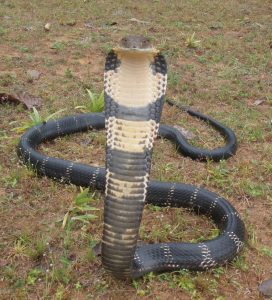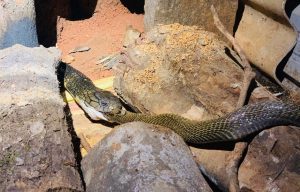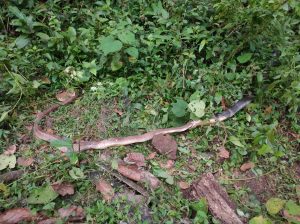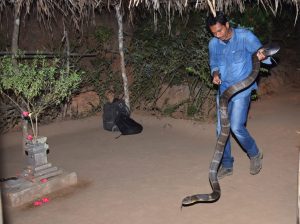
Why King Cobras are getting ‘Aadhaar numbers’ in Western Ghats
Agumbe researchers probe secret and shy lives of the King Cobra; the reptile, popularly seen as a ferocious snake, actually leads a fairly sedate life staying put inside a home range of 8-10 km. It stirs out for just two reasons: food and sex

A project is underway in Western Ghats to give an Aadhaar-like unique identification number to King Cobras, one of the world’s largest snakes and an apex predator in the thick forests of the region.
The staff at Karnataka’s Agumbe Rainforest Research Station (ARRS) have tagged over 100 King Cobras with a tiny chip, the size of a Basmati rice grain. The chip comes with a 15-digit unique number, which pops up when the tagged snakes are scanned with a small device.
Aadhaar project of the King Cobras
The chip, which is placed between the skin and the muscle of the snake through a simple procedure, is helping researchers find new ways to probe these still-mysterious snakes.
Also read: Where did the king go? Dehradun zoo and the mystery of the missing cobra
In a recent study, researchers tied a scanner to a long stick and took it close enough to scan competing male King Cobras pursuing a female. They identified some of the raunchy males by their unique number and found that they had strayed from their home range, which was as far as 10 km away. “This is stunning information about a slow-moving limbless reptile, which can slither just two or three km a day,” says Ajay Giri, Director of ARRS.

The ‘Aadhaar project of the King Cobras’, as the researchers like to put it, is the latest initiative of ARRS, which was set up in 2007 by herpetologist Romulus Whitaker. Agumbe is in Karnataka’s side of Western Ghats, some 350 km from Bengaluru, and is known for the high amount of rainfall it receives. Until ARRS started work, the King Cobras had never been studied in India.
Tracking individual snakes in deep forest
The flagship initiative of the research centre is a radio telemetry project under which King Cobras are fitted with a small transmitter and released back into the wild. A team of three experts continuously track these snakes, for a period of three years, documenting their habitat, feeding, mating and other behaviour.
Seven snakes — five males and two females — have been monitored in two phases by the project so far: between 2008 and 2011 and between 2018 and 2021.
The researchers have found that the King Cobra, popularly seen as a ferocious snake, actually leads a fairly sedate life staying put inside a home range of 8-10 km. These solitary and diurnal creatures sleep most of their time. They occasionally wake up to bask in the sun for about 30 minutes and then get back to sleep.
Features: So you thought King Cobra is a single species? Study proves otherwise
They stir out of their sedentary lifestyle for just two reasons: to find food or sex. They feed on other snakes, mostly rat snakes, spectacled cobras and pit vipers.
Vipers are like biscuits
Rat snakes, which can grow up to six feet, provide a wholesome meal, which means the King Cobra can go without eating again for another 20 to 25 days, and can devote fully to sleeping or basking.
Cobras are smaller and will require it to get back to hunting sooner. “The much smaller Vipers are like biscuits. They don’t satiate King Cobra’s hunger,” says Giri.

King Cobras have also been spotted preying on baby pythons, small monitor lizards and occasionally on each other. Researchers have documented several instances of cannibalistic behaviour in these snakes. A large male once ate a smaller female, which had been fitted with a transmitter, bringing its study to an abrupt halt. “It was a heartbreak,” says Giri.
Discerning predator follows scent trail
The King Cobra has turned out to be a discerning predator, which hunts its prey using different techniques to avoid injury. When it chases cobras and vipers, which are venomous, it pursues them patiently, waiting for an opportunity to strike always on their head. This minimises the chances of the prey fighting back with a bite of its own and injecting its poison into the King Cobra.
But if it is a non-venomous rat snake, the King takes it easy and lands a bite anywhere on the body.
Also read: Illegal trade in exotic animals booms as Indian ‘pet lovers’ go wild
Sometimes the bitten prey may flee and die somewhere else. Researchers have noted the King Cobra searching for the dead meat in nearby areas for as many as five days. The King Cobras follow the scent trail of their prey. If a rat snake takes a zig zag route while fleeing, the predator follows exactly the same path.

It has been noted that sometimes a prey, while fleeing in panic, may take a circular route across the trees and come back to where it started. Though it is much easier to get at the prey now, the King Cobra opts to follow the scent trail, takes the same circular route across the trees, and comes back to the new location of the prey.
Mating season
Once a year, during the mating season between March and May, King Cobras may leave their home range and, now as we know, travel up to 10 km to find a mate.
The females secrete pheromones attracting several suitors. The competing males engage in a ritualistic duel, wrestling with their bodies, head butting each other, but keeping their fangs away. They do this till the loser flees and the winner gets the female, who now has a choice either to yield or flee or become his next meal.
The last two options are more likely if the female has already mated with another male and has eggs developing in her body. In the early days of ARRS, its researchers filmed a gut-wrenching incident, which went globally viral, of a male killing a pregnant female during an attempted courtship.
The female, which grows up to 8-10 feet, is at a disadvantage when compared to the male, which averages at 14.5 feet in the Western Ghats.
Nests are an engineering marvel
If the courtship is successful and the female stays alive, the couple spend 20 to 25 days together mating, sleeping and basking.
Then the male leaves and returns to his home range while the female builds an incredible nest that looks like a three-feet tall pyramid made of dry leaves.
She gathers and layers the leaves one over the other like human rooftop tiles to create an impregnable fortress, which does not let even a drop of water to trickle inside, an astounding feat in a tropical forest, which gets one of the highest rainfalls in India.
She builds a chamber at the heart of the nest and lays 20 to 40 eggs. She then rests for a day sitting on top of the nest and then goes away abandoning it. Though research is still in progress, scientists have measured that the nest maintains a constant temperature of 26 to 27 degree centigrade inside.
The eggs hatch after 85 days and the new-born snakelings go their own way after birth. “Though we need more research on how they survive, nature seems to show a way out. At the time these eggs hatch, baby vipers are also born, on which they perhaps feed,” says Giri.
Signs of intelligence
Researchers are also finding that these snakes are not mindless beasts, which are wired to play out their instincts. They think and act, even show signs of intelligence.
“King Cobra roadkills are rare. I have seen them waiting carefully to let the traffic pass before crossing a road. We have observed many instances of thoughtful behaviour in them,” says Giri.
If a human activity like digging or construction begins in their habitat, the King Cobras have been spotted keeping a wary eye on them. They don’t flee, try to coexist with the intruders, but keep a close watch on their activities.
Researchers have observed King Cobras very careful while feeding on monitor lizards, whose sharp claws can slit their throat from inside. While swallowing dead monitor lizards, the snakes position them in such a way that their limbs with claws are folded inwards. If they think they are not doing it right, they may regurgitate the lizard and swallow it again.
King Cobras keep low profiles
The King Cobras are not curious and avoid anything that moves but is not their food. They have been observed shying away from encountering humans, cattle and even monkeys.
Even when they get close to a human habitat, usually while chasing a prey, they avoid unnecessary contact and keep a low profile. Humans may pass by them without realising that they are in the presence of one of the world’s most venomous snakes.
It is said that King Cobra has enough venom to kill an elephant. But its venom, a neurotoxin like the spectacled cobra’s, is precious and strictly reserved to hunt for food. The King studiously flees even from accidental encounters with other animals and instances of these snakes biting a human are exceedingly rare.
There is no antidote to the King Cobra venom in India and there is no need for that, says Giri. “People get bitten only when they fool around with these snakes to show how brave they are. I have rescued King Cobras for 15 years and not been bitten even once,” he adds.
Learning to live with the snakes
Thanks to the ARRS researchers’ outreach, local communities now understand the behaviour of these snakes and are learning to live with them.

ARRS routinely gets distress calls from people who have spotted a King Cobra close to their home or farm. A team rushes to the spot and tries to convince the villagers not to interfere with the snake as it is unlikely to harm them and will go away on its own.
“When we respond to these calls, we may usually see a King Cobra eating a prey and an excited crowd nearby. We spend hours calming down the crowd and talking to them about how we can co-exist with King Cobra. They usually appreciate the fact that the King Cobra controls the population of other snakes and agree not to harm it,” says Giri. By that time, the King Cobra would have finished its meal and moved away.
But if the snake is too close to a human habitat or the crowd too restless, it is rescued and released in the forest.
King Cobras are still a mystery
The health of any ecology is tied to the wellbeing of its apex predator. Though new data about the King Cobra is trickling in, there is much we do not know about these snakes.
While they have been marked vulnerable by the IUCN Red List of Threatened Species, we do not even know how many King Cobras are there in any given region of the Western Ghats.
Researchers mostly track and tag the snakes, which are sighted by the humans, and have no clue about those living in the deep forest. The sightings have increased over the years but they are more of an indicator of deforestation and increase in human activity than a rise in the number of the King Cobras.
Sometimes villagers may count the same snake twice if it is spotted at different intervals. The double counting happens frequently as the King Cobra changes colour from yellowish brown in summer to black in winter.
“This is the problem the Aadhaar project for the King Cobras is solving as it helps us to keep a unique count of the individuals. This project will help us to find out how many snakes are out there. Give us a few years, we will be able to make an estimate,” says Giri.

